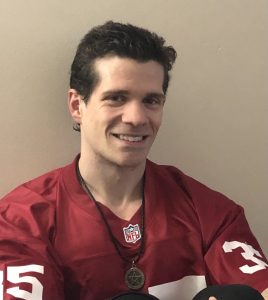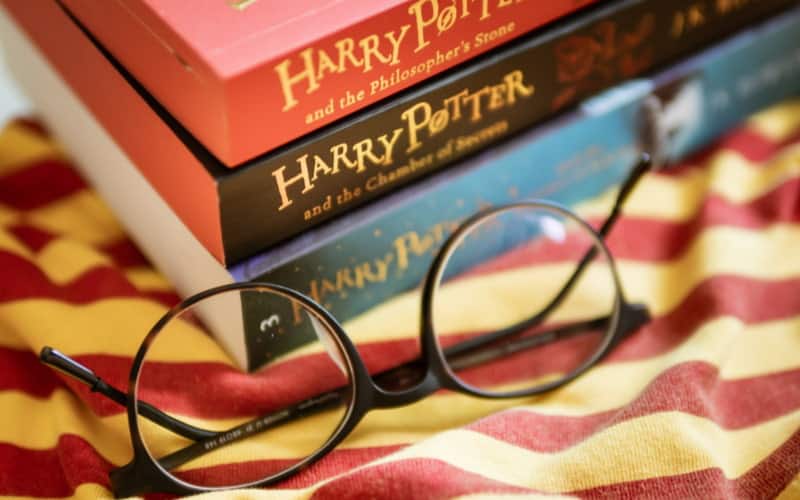In many franchises, the books or novelizations always go into greater detail than the movies, and Harry Potter is no different.
While there is an endless array of reasons why Harry Potter books are awesome and more than worth the read, some reasons stand out better than others. Let’s explore the top ten.
Contents
- 1 – Books and Movies Dramatically Differ
- 2 – Ron Weasley’s Character
- 3 – Professor Dumbledore’s Character
- 4 – More Interesting Characters Cut From the Films or Glossed Over
- 5 – Greater Insights on Dumbledore’s Backstory
- 6 – Greater Insights on Tom Riddle’s Transition Into Lord Voldemort
- 7 – Books Take on a Much Darker Tone
- 8 – Ravenclaw House
- 9 – Better Character Arcs
- 10 – Greater Understanding of the Wizarding World
1 – Books and Movies Dramatically Differ
While the movies do a good job of covering the primary plot points shown in each Harry Potter book, they are night and day differences from the books.
For example, in Harry Potter and the Prisoner of Azkaban, Sirius Black sends Harry his Firebolt on Christmas in the book. In the movie, Harry receives the Firebolt in the film’s final scene.
You can find a slew of examples in Harry Potter and the Goblet of Fire. Because of time constraints, the producers controversially cut the Quidditch World Cup out of the movie, whereas in the book, J.K. Rowling includes the entire game.
When the Death Eaters briefly reunite following the World Cup, they’re only wreaking havoc in the film. But in the books, they are also tormenting the Muggle family who owns the grounds near the site of the World Cup.
Also, during the same scene in the book, Harry and the others escape into the woods, confront Draco Malfoy, and they also find the House Elf Winky struggling against an unseen force. In the movies, Harry trips, gets knocked out, and sees Barty Crouch Jr. cast the Dark Mark.
The book also introduces the reader to what it is like during the height of Lord Voldemort’s power shortly after Crouch Jr. conjured the Dark Mark. The movie skips to Harry, Ron, and Hermione heading to school on the Hogwarts Express.
2 – Ron Weasley’s Character
Ron Weasley is arguably the most loyal supporting character in the series, minus the time he briefly abandoned Harry after the latter’s name flew out of the Goblet of Fire and the time he left Harry and Hermione during their hunt for Horcruxes in Deathly Hallows.
He’s also fearless, as seen when he accompanied Harry into the Chamber of Secrets in the second book, and to the Ministry of Magic in the fifth.
If you only watch the movies, then you’re going to look at Ron as though he’s nothing but a comic relief prop. Take a scene from Harry Potter and the Half-Blood Prince, when Professor McGonagall openly wondered why it was always Harry, Ron, and Hermione at the center of trouble.
“Believe me, Professor,” Ron said, “I’ve been asking myself the same question for the past six years.”
Ron’s quip was nothing new by this point in the films. He’d often been the one making squeamish faces, even for no reason.
Ron was also the one muttering comical or rhetorical statements under his breath. One prime example occurred when McGonagall told them about the Chamber of Secrets in the film version.
3 – Professor Dumbledore’s Character
When you watched the movies, you probably noticed that one man plays Albus Dumbledore in the first two films (Richard Harris), and another portrays him in the final six (Michael Gambon).
Harris’ Dumbledore is spot on, but Gambon’s portrayal was a poor impression of the Hogwarts’ Headmaster. There isn’t a single scene in the movies that sums this up better than when Dumbledore asked Harry if he placed his name in the Goblet of Fire.
In the book, true to his original character, Dumbledore “calmly” asks Harry if he put his name in the Goblet. In the movie, Dumbledore slams Harry against a trophy case and borderline shouted the question.
The books mention a few instances when Dumbledore loses his temper, like when Dementors invaded the Quidditch pitch in Prisoner of Azkaban, and when Barty Crouch Jr. was revealed to be impersonating Mad-Eye Moody.
But in the books, Dumbledore is almost always the calmest man in the room even when an enraged Harry destroyed the man’s possessions in Chapter 37 of Order of the Phoenix.
4 – More Interesting Characters Cut From the Films or Glossed Over
Once again, because of time constraints, the films leave out a plethora of characters. Peeves the Poltergeist is the most notable. And while Peeves was supposed to appear in the Sorcerer’s Stone film, they cut his scenes.
Winky the House Elf, a prominent character in Harry Potter and the Goblet of Fire, is also cut. Ludo Bagman is too, despite his major role in the same book.
History of Magic teacher Cuthbert Binns is never seen in the movies, although he appeared in a notable scene during Harry Potter and the Chamber of Secrets.
In the film, Professor McGonagall takes the starring role in telling the students about Hogwarts’ four founders, and the secret chamber Salazar Slytherin left.
5 – Greater Insights on Dumbledore’s Backstory
In Harry Potter and the Deathly Hallows, we learn that Dumbledore, arguably the most flawless character in the series to that point, was once a rather corrupt wizard.
Dumbledore and his best friend at the time, Gellert Grindelwald, envision a world where they would lead wizards out of hiding and rule over Muggles. Sounds like something Lord Voldemort tried to do in the 1970s and again, in the 1990s, right?
In the movies, we only get the vibe that Dumbledore is rather careless and selfish in his youth, as his brother, Aberforth, stated to the golden trio when they showed up in Hogsmeade shortly before the Battle of Hogwarts.
Hermione mentioned that their sister, Ariana, died at a young age. But in the books, we learn that a duel occurred when Albus and Grindelwald had a falling out.
A three-way fight erupted between Albus, Aberforth, and Grindelwald, and Ariana ended up dead. Here, we learn Albus spent the rest of his life torturing himself as to whether he fired the fatal curse that killed his sister, something that didn’t hit home in the films.
6 – Greater Insights on Tom Riddle’s Transition Into Lord Voldemort
In the Harry Potter and the Half-Blood Prince film, we only see a couple of Pensieve scenes, with the most prominent scene being the flashback to when Dumbledore first met an eleven-year-old Tom Riddle.
But in the book, we saw quite a few. One included the Gaunt family, particularly zeroing in on Voldemort’s mother, Merope. Another scene in the book but cut from the film included a young Voldemort learning of his Muggle heritage.
And the book did a much better job of showing us how Voldemort went from being a good-looking boy to the inhuman specimen he transformed into.
We also caught an in-depth look at how Voldemort charmed people into trusting him, like Hepzibah Smith and Professor Horace Slughborn. In the movies, Voldemort (still known as Tom Riddle) merely approaches Professor Slughhorn, before asking him about Horcruxes.
When Rowling fleshed out the scenes in the book, Voldemort, still known as Tom Riddle at the time, played up to Slughorn before asking about Horcruxes.
Smith, whose character never appeared in the film, already built trust with Riddle, before showing him Helga Hufflepuff’s cup. Riddle would later murder Smith and turn the cup into a Horcrux.
7 – Books Take on a Much Darker Tone
While the movies grow steadily darker, symbolized by the darker lighting from Prisoner of Azkaban and onward, they still have a sense of comic relief.
Once again, let’s turn our attention back to Half-Blood Prince, where we see several lighthearted moments, despite the dark tone of the book.
The potions scene, for example, depicts comical moments like when Harry and Ron fought over a potions textbook, Hermione’s hair frizzling as she struggles to brew a potion, and the running gag of Seamus Finnigan having something blowing up in his face.
While the film had its fair share of serious moments, there was hardly anything to laugh about in the books. I personally first read Half-Blood Prince when it was first released 18 years ago, and to this day, I remember the sense of dread that I felt throughout the novel.
8 – Ravenclaw House
The films botched Ravenclaw House’s colors and logo. In the books, Ravenclaw’s symbol is an eagle, not a raven, and the name refers to the claw on an eagle’s talon. The colors are also blue and bronze. In the films, they changed the House colors to blue and silver.
While this is admittedly a small detail, the books take precedence over the movies. So, blue and bronze, plus the eagle symbol, are also the colors and symbol in canon.
Padma Patil, the identical twin (in the books) of Gryffindor student Parvati Patil, is also in Gryffindor in the films as opposed to Ravenclaw, the House she is in during the books.
Fortunately, characters like Luna Lovegood remained in Ravenclaw during the films.
9 – Better Character Arcs
Harry, Ron, and Hermione had brilliant arcs in the books and the films. But many supporting characters, like Ginny Weasley and Neville Longbottom, didn’t have the same, smooth arcs.
In the books, Ginny went from being a shy girl, especially around Harry, to one of the coolest and most popular girls in her Year. But in the films, Ginny, while she has her moments, is little more than a background character.
Ginny shows her bravery in flashes, like during the scene when Bellatrix Lestrange and Fenrir Greyback set the Burrow on fire. But in the books, Ginny’s confidence, bravery, and witty personality show up in the middle of Goblet of Fire and onward.
Neville’s arc grows in the fifth film, just as it does in the fifth book. However, like Ginny’s arc, we only see Neville show off his bravery in flashes, as when he shouts at Harry to not give the Death Eaters the prophecy during the Battle of the Department of Mysteries.
In the books, we see numerous instances of Neville growing into the brave soul that exemplified Gryffindor House. For example, he is one of only a few members of Dumbledore’s Army to fight in the Battle of the Astronomy Tower.
Neville is also a leader during his seventh year at Hogwarts in resisting the Carrows’ and Slytherin House’s reign of terror on the school. In the films, Neville’s only real other moments of bravery came during the Battle of Hogwarts.
10 – Greater Understanding of the Wizarding World
The books also give us a greater view of the Wizarding World than the films, which only showed bits and pieces of it, namely Diagon Alley.
We only get a taste of Quidditch in the films, and we get next to nothing about what wizards do for careers. The films either lightly or never touch on Apparition, why so few wizards return as ghosts, money in the wizarding world, and even points of interest like Hogsmeade Village.
In the books, we enjoy a closer look at Diagon Alley, see numerous scenes taking place in Hogsmeade, explore Hogwarts in greater depth, see a slew of different career paths wizards could take, and even enjoy ten Quidditch matches of varying lengths.

Sion Fawkes has been covering Star Wars since January 2022, expanding his expertise in Star Wars Canon, Legends, and MCU. When not writing, you can find Sion in the gym or running trails. He also likes watching sports and listening to audiobooks.
